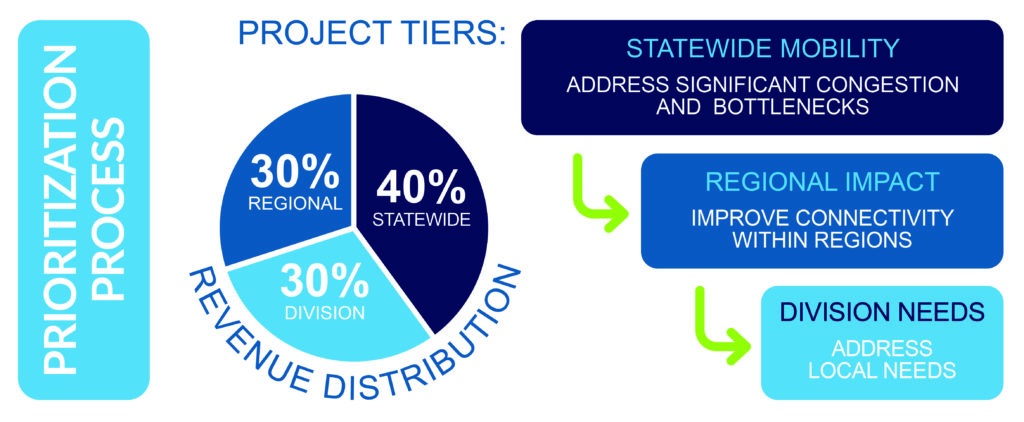THE STRATEGIC PRIORITIZATION PROCESS
The Strategic Prioritization Process is a data-driven, transparent method for prioritizing transportation projects and is used to develop the State Transportation Improvement Program (STIP)/ Metropolitan Transportation Improvement Program (TIP), which identify the projects that will be funded during a 10-year period. Prioritization scores all roadway, public transportation, bicycle & pedestrian, rail, ferry, and aviation projects based upon approved criteria.
HOW IT WORKS
Projects receive a percentage of available revenue in the following three categories: Statewide Mobility (40%), Regional Impact (30%), and Division Needs (30%). The Statewide Mobility projects are 100% data driven and selected based on quantitative scores. Regional Impact projects focus on improving connectivity within regions (7). Selection is based on 70% data and 30% local input. Division Needs projects focus on addressing local needs, and selection is based on 50% data and 50% local input. The WMPO along with NCDOT Division 3 will assign local input points to the Regional Impact and Division Needs tier projects based on approved methodology. Projects with the highest scores will have a greater chance of being programmed into the STIP/Metropolitan TIP.

Prioritization 7.0 Process Schedule 2023-2025
| New project submittals to NCDOT | July – October 2023 |
| MPOs, RPOs, Divisions develop Input Point Methodologies | November 2023 – March 2024 |
| Release of P7.0 Quantitative Scores and Statewide Mobility programmed projects | May 2024 |
| Regional Impact Local Input Point Assignment | June – August 2024 |
| Regional Impact total scores and programmed projects released | September 2024 |
| Division Needs Local Input Point Assignment | October – November 2024 |
| Program Division Needs projects | December 2024 |
| NCDOT releases Draft 2026-2035 STIP/MPO TIP | January 2025 |
To learn more about the Prioritization 7.0 process, visit NCDOT’s Prioritization Resources page.
Local Input Point Methodology
The WMPO Board approved its P7.0 Local Input Point Methodology on February 28, 2024, to guide the assignment of the organization’s 1600 local input points for projects scored for Regional Impact and Division Needs funding. This methodology is intended to ensure a process that is both data-driven and responsive to local needs. The methodology has been developed to meet the requirements of Session Law 2012-84 (Senate Bill 890), which requires that MPOs and RPOs have a process that includes at least two criteria, with at least one being qualitative, for determining project prioritization. Per the adopted methodology, the WMPO will evaluate projects for the assignment of local input points based on the following criteria: the Prioritization 7.0 quantitative score; coordination of point assignment with Division 3; consistency with WMPO adopted plans; status of project in development; and the number of Prioritization cycles the project has been submitted by the WMPO.
Regional Impact Projects Local Input Point Assignment
Based on the WMPO’s adopted local input point methodology, 1600 local input points were assigned to projects eligible in the Regional Impact Tier. The WMPO Board approved the point assignment after a 14-day public comment period on August 31, 2024.
Division Needs Projects LIP Assignment
Based on the WMPO’s adopted local input point methodology, the draft assignment of the WMPO’s 1600 local input points for the Division Needs Tier Project has been developed. The WMPO Board opened a 14-day public comment period for the draft point assignment on October 30, 2024. Following this period, the WMPO Board approved the Division Needs Local Input Point Assignment on November 20, 2024.